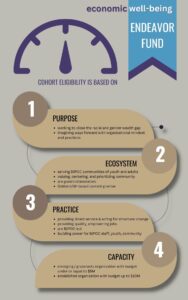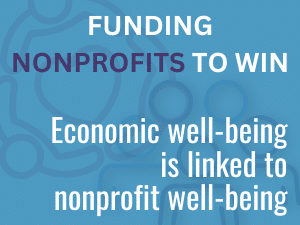Operationalizing Trust-based Philanthropy: A Learning Lab for the Field
Endeavor Fund as case study, part two
Today, we’re continuing the case study of how the Walter & Elise Haas Fund established the Endeavor Fund as one way to operationalize trust-based philanthropy. Part one of this case study walked through the process of establishing the Endeavor Fund, from community-led insight as research, to screening and deeper learning interviews, to W&EHF-led transparent financial analysis, to compensation for community and grantseeker’s time and insights.
This blog, part two of the case study, offers reflection: to learn out loud and in community with you. This post shares our reasons for some of our key choices, and the mistakes we know we’ve made so far.
As always, this blog series is an invitation into a learning lab. We want to hear from you. What questions or sparks of new ideas come to mind as you read this blog? What have we missed? What would you add? What have you already done in your own practices? How might we, and all of us, do better?
Need a refresher? Review the Endeavor Fund process.
How We Were Trying to Operationalize Trust
The Endeavor Fund has two central tenets: to close the racial and gender wealth gap, and to improve nonprofit well-being, especially through supporting nonprofit jobs as quality, empowering jobs. That the burden of low-wage and usually front-line nonprofit work — what some call poverty jobs — seems to be carried disproportionately by women of color workers is not lost on us. These tenets inform and are embedded in our choices in establishing the Endeavor Fund with nonprofit organizations.

We tried to center nonprofit organizations in the process. This means we did the work instead of the grantseeker, including: transcribing the entire interview and sharing it back within 48 hours for them to check; and analyzing financial materials, such as 990s available from the IRS and Candid. We started with a rubric that turned into the eligibility questions, and then the deeper learning interview questions. We sent the 18 interview questions to the organizations at the start of November, in advance of the January interviews. We went to their offices to meet them where they are instead of having them come to us.
We spoke explicitly about shifting power to them. One of the 18 questions in the deeper learning interview was, “How would you have us be accountable to you?” We invited them explicitly to tell us how they want us to show up for them. We listened carefully to them in order to better serve them and their communities. Most of the 30-minute screening conversation was reserved for their questions, because we already knew the organizations from past grants and from their work in the community. We considered that we didn’t need to learn about them as much as they needed to learn to trust us.
We were as transparent as possible. We were honest about what we wanted and what we knew, as well as what we didn’t know. We told each organization we spoke to that a key tenet of the Endeavor Fund was to “fund them to win on their own terms,” and it follows that we didn’t, and couldn’t, have
What We Didn’t Do
There are choices we made through this process or things we forgot to do that impacted former or current grantees. You could even argue that some of these choices don’t entirely line up with a holistic trust-based approach.
For example, the W&EHF did not use an open call, an RFP, nor written proposals for the process. This was a deliberate choice. There are benefits for doing it this way, but we also acknowledge the clear disadvantage to creating a closed grantmaking program — we missed out on brilliant organizations newly introducing themselves to us. What we focused on was the reality that W&EHF’s decision to make larger grants within the same grantmaking budget meant a trade-off to having grantmaking relationships with many fewer organizations. As an organization with ten staff in total, we didn’t think we could take the care needed nor be responsible to people submitting LOIs in an open call. The trade we made was to focus our efforts on known organizations and allow our staff time in cultivating deeper relationships in order to serve Endeavor Fund grantees better.
Some of our choices were mistakes. We did not share our rubric publicly, nor with the organizations that were under consideration for the Endeavor Fund cohort. This was something we didn’t think about doing until far too late. In addition, we could have had a more individualized approach to communicating the sunset of three program areas — Economic Security, Education, and Safety Net — and the resulting exit of grantees. Though we had one-on-one conversations with approximately 30% of grantees about the details of the transition and exit, and indicated that renewal grants were unlikely, we did not have one-on-ones with 100% of impacted grantees. We wish we had spoken to everyone directly.
Inviting Your Thoughts
Frankly, there’s even more to the process than we’ve covered in these two posts, particularly around what we learned from structuring the Endeavor Fund this way, our in-depth interviews, exit conversations with former grantees, and holding a town hall with all former grantees of the closed programs. We plan on sharing some of those learnings in future blogs. These first two posts summarize the broad strokes of our process of intentionally activating the trust-based practices we saw within reach for us. The story, at this moment, is about the choices we’ve made thus far.
There are tweaks we would make — like share the rubric sooner, be more transparent to all grantees — and, as we take a moment to pause, reflect, and actively learn, there is much we would do again in the same or similar ways. Working as a team across roles was transformational for our organization. Centering grantees in our choices gets another resounding yes. Taking these steps, that were also steps into the unknown — another yes.
A Philanthropy Learning Lab
We offer this case study as the first part of a philanthropy learning lab and blog series on how a foundation might operationalize trust-based practices. As W&EHF aims to be in a state of constant public learning, with the mindset that mistakes, just as much as successes, are opportunities for progress as long we are moving forward, thoughtfully, and in community, we invite you to tell us:
What’s your take? What do you notice? What would you change? What questions to do you have?
Let us know. We’re here to learn and do better.
Economic Well-being, Blog, Grantmaking, News


